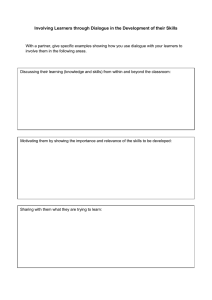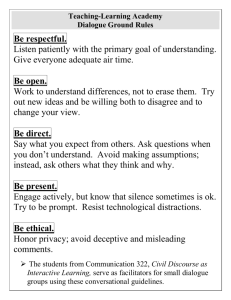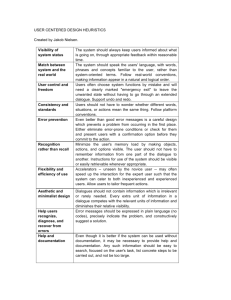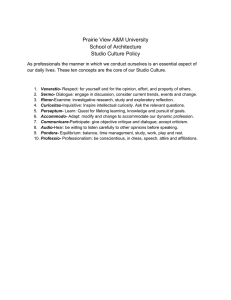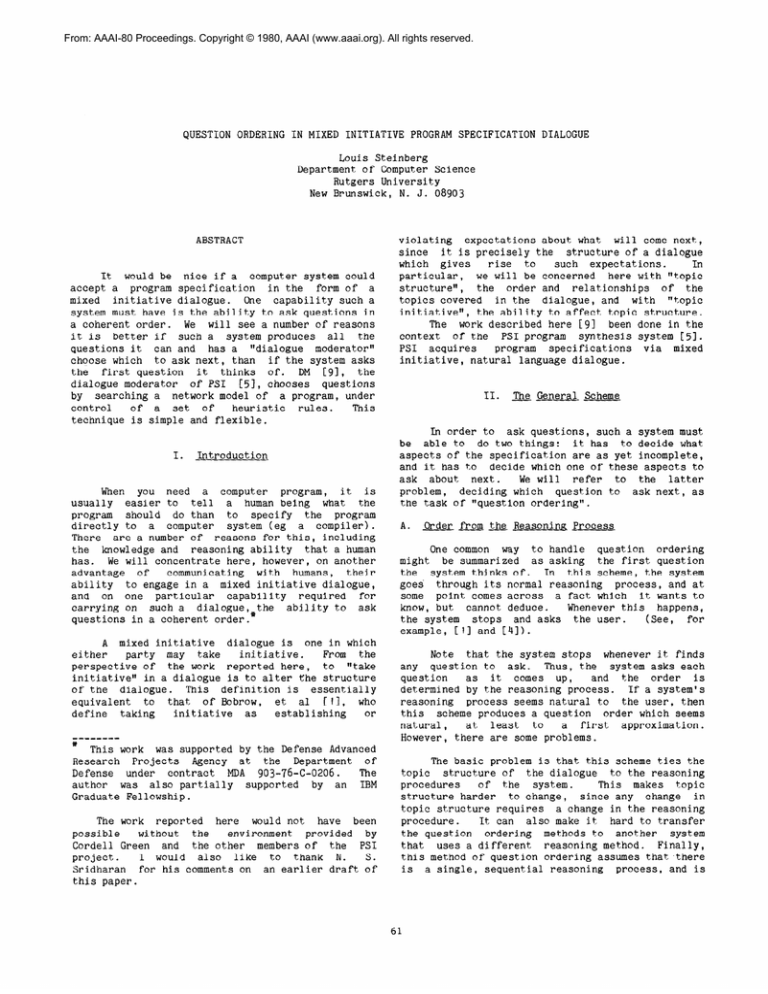
From: AAAI-80 Proceedings. Copyright © 1980, AAAI (www.aaai.org). All rights reserved.
QUESTION ORDERING IN MIXED INITIATIVE PROGRAM SPECIFICATION DIALOGUE
Louis Steinberg
Department of Computer Science
Rutgers University
New Brunswick, N. J. 08903
ABSTRACT
It would be nice if a computer system could
accept a program specification in the form of a
mixed initiative dialogue. One capability such a
system must have is the ability to ask questions in
a coherent order. We will see a number of reasons
it is better if such a system produces all the
questions it can and has a "dialogue moderator"
choose which to ask next, than if the system asks
the first question it thinks of. DM [9I,
the
dialogue moderator of PSI C51, chooses questions
by searching a network model of a program, under
control
of a set of
This
heuristic rules.
technique is simple and flexible.
I.
Introduction
When you need a computer program, it is
usually easier to tell a human being what the
program should do than to specify the program
directly to a computer system (eg a compiler).
There are a number of reasons for this, including
the knowledge and reasoning ability that a human
has. We will concentrate here, however, on another
advantage of
communicating with humans, their
ability to engage in a mixed initiative dialogue,
and on one particular capability required for
carrying on such a dialogue,*the ability to ask
questions in a coherent order.
A mixed initiative dialogue is one in which
party may take
initiative.
From the
either
perspective of the work reported here, to "take
initiative" in a dialogue is to alter the structure
of the dialogue. This definition is essentially
equivalent to that of Bobrow, et al [II, who
initiative as
establishing or
define taking
--m---w' This work was supported by the Defense Advanced
Research Projects Agency at the Department of
Defense under contract MDA 903-76-C-0206. The
author was also partially supported by an IBM
Graduate Fellowship.
The work reported here would not have been
possible
without the
environment provided by
Cordell Green and the other members of the PSI
project.
I would also like to thank N.
S.
Sridharan for his comments on an earlier draft of
this paper.
violating expectations about what will come next,
since it is precisely the structure of a dialogue
which gives
rise to
such expectations.
In
particular, we will be concerned here with "topic
structure", the order and relationships of the
topics covered in the dialogue, and with "topic
initiative", the ability to affect topic structure.
The work described here 191 been done in the
context of the PSI program synthesis system [5].
PSI acquires
program specifications via mixed
initiative, natural language dialogue.
II. The General Scheme
In order to ask questions, such a system must
be able to do two things: it has to decide what
aspects of the specification are as yet incomplete,
and it has to decide which one of these aspects to
ask about next.
We will refer to the latter
problem, deciding which question to ask next, as
the task of "question ordering".
A.
Order from the Reasoning Process
One common way to handle question ordering
might be summarized as asking the first question
the system thinks of. In this scheme, the system
goes through its normal reasoning process, and at
some point comes across a fact which it wants to
know, but cannot deduce.
Whenever this happens,
the system stops and asks the user.
(See, for
example, [11 and 143).
Note that the system stops whenever it finds
any question to ask. Thus, the system asks each
question as it comes up,
and the order is
determined by the reasoning process. If a system's
reasoning process seems natural to the user, then
this scheme produces a question order which seems
at least to
a first approximation.
natural,
However, there are some problems.
The basic problem is that this scheme ties the
topic structure of the dialogue to the reasoning
procedures of the system.
This makes topic
structure harder to change, since any change in
topic structure requires a change in the reasoning
procedure.
It can also make it hard to transfer
the question ordering methods to another system
that uses a different reasoning method. Finally,
this method of question ordering assumes that there
is a single, sequential reasoning process, and is
61
not possible in a
HEARSAY-II [71.
B.
system structure such as that of
Order from a Dialog
Moderator
A better scheme is to have the reasoning
process produce as many questions as it can, and to
use some other mechanism to select a single one of
them to ask next. This scheme largely avoids the
problems of the previous one. Its main drawback is
that it requires a reasoning process which is able
to produce more than one question at a time. An
additional advantage of this scheme is that it
allows us to implement question ordering in a
separate module, with a clearly defined interface
to the rest of the system. I have termed such a
module a "dialogue moderatortt.
Thus, the dialogue moderator is given a list
of all the questions currently open, and must
choose which one is to be asked next, so as to keep
the dialogue well structured. Much recent research
(eg [2], C61, [8]>
has shown that structure of a
dialogue is closely tied to the structure of goals
and plans
being
pursued by
the
dialogue's
participants. One might therefore imagine that the
dialogue moderator needs a complete model of goals
and plans, both those of the system and those of
the user.
However, in a program specification
dialogue, the goals and plans of both participants
are tied very closely to the structure of the
program. As will be seen, it has been possible in
PSI to use a simple model of the program structure
instead of a complex model of goals and plans.
(It might be argued that any system which
handles natural language will eventually need the
full model of goals and plans anyway, so using a
simpler model here is no savings in the long run.
It should be noted, however, that mixed initiative
does not necessarily imply natural language.
A
useful system might be constructed which handles
mixed initiative dialogue in some formal language.)
III. J&
Specific Method
DM is the dialogue moderator of the PSI
system. As noted above, DM maintains a simplified
model of the program being specified. The program
is viewed as a structured set of objects.
Each
object is either a piece of algorithm or a piece of
data structure - the pieces of algorithm correspond
roughly to the executable statements of a program,
and the pieces of data structure correspond roughly
to the variable declarations. A specific loop or a
specific input
operation might be algorithmic
objects, while a set or a 5-tuple might be data
structure objects.
These
objects
are
structured by
two
relationships: an object may be a subpart of
another (eg an input operation might be a step of a
loop, and thus one of its subparts), and an
algorithm object may use a data structure object
(eg an input operation "usesttthe data structure it
inputs).
DM represents this structure in a standard
network form; nodes represent the objects, and arcs
represent the
relations subpart/superpart and
uses/used-by. Each node also has associated with
it a list
of questions about the object it
represents. (A question asks about some attribute
of some specific object.
The objects, relations,
and questions come from other modules of PSI.)
In order to choose the next question to ask,
DM searches the net, starting at the "present
topic". The present topic is the object currently
being discussed.
Determining which object this is
is a difficult and important problem in its own
right, involving the syntax of the user's sentences
as well as the status of the program specification,
and has not been seriously dealt with in this work.
Instead, some simple heuristics are used, the main
one being to assume that most of the time the user
will be talking about the object that the system
just asked about.
Once the present topic has been chosen, the
search proceeds, under control of a set of rules.
(The rules are listed in the appendix. See [9]
for a discussion of the specific rules.) Each time
the search reaches an object, a list of rules is
chosen (depending on whether the object is a piece
of algorithm or data structure) and these rules are
applied in order. Some say to look for a specific
kind of question about the current object. Others
say to move along some particular kind of arc from
the current object, and recursively apply the rules
on the object we reach. If no question is found by
this recursive application, we come back and
continue applying the rules here. If at any point
a rule that looks for questions finds one, that
question is the one to ask, and the search stops.
This scheme of moving through the net and
looking for questions, under control of a set of
rules, has proven to be simple and flexible.
A related technique was used in SCHOLAR [3].
SCHOLAR is a CA1 system which teaches geography by
engaging in a mixed initiative dialogue with the
student.
Both participants may ask and answer
questions.
SCHOLAR chooses which question to ask
by a random (rather than rule directed) walk on a
net which encodes its knowledge about geography.
As ultimately envisioned, SCHOLAR would teach in a
Socratic manner, that is, by asking a carefully
designed sequence
of questions.
However, the
structure of goals and plans in such a dialogue is
probably very different from the structure of the
net as discussed in [31.
Because of this, a
scheme of moving through this net is unlikely to be
useful for producing such a sequence of questions.
DM's question
ordering behavior has been
tested in two ways.
First, a log of runs of PSI
was surveyed. This log included 42 dialogues which
were essentially complete.
Each dialogue was
checked, both to see if the user complained about
the question ordering (there is a comment feature
that can be used for such complaints), and also to
see if
the question
order was
subjectively
acceptable. Except for one instance, later traced
to a program bug, DM's behavior was correct. This
test was too subjective, however, so a simulated
dialogue was recorded, with myself playing the role
of PSI and a programmer from outside the PSI group
The inputs DM would have gotten
as the user.
during this dialogue were hand coded and given to
DM, and the questions DM chose were compared with
those I had chosen. DM had to choose a question at
sixteen points, with two to seven questions to
choose from. The correct question was chosen at
thirteen of these points.
An analysis of the
errors indicates that they could be removed by some
straightforward extensions
current
of
the
methodology, particularly by maintaining
more
history of how the dialogue got to the present
topic.
IV.
A5) Look at all objects that are SUB-PARTS of this
object.
A61 Are there questions about the EXIT-TEST of this
object?
A7) Look at all objects that are SUPER-PARTS of
this object.
Rules for Data Structures
Dl) Look at all objects that are SUB-PARTS of this
object.
D2) Are there questions about the STRUCTURE of this
object?
D3) Are there OTHER questions about this object?
D4) Look at all objects that are SUPER-PARTS of
this object.
D5) Look at all objects that USE this object.
Conclusions
REFERENCES
Thus we see that it is advantageous for a
system which engages in mixed initiative dialogue
to have the reasoning modules produce all the
questions they can at each point in the dialogue,
and to have a separate dialogue moderator choose
which one to ask next.
In such a system, the
question ordering mechanism is decoupled from the
reasoning process, so that either can be modified
without changing the other. A given mechanism for
selecting one of the proposed questions can be more
easily transferred to a system with very different
reasoning mechanism.
Also, multiple
parallel
reasoning processes can be used with this scheme.
Cl] Bobrow, D., Kaplan, R., Kay, M., Norman, D.,
Thompson, H., Winograd, T., "GUS, A FrameDriven
Dialogue
System." Artificial
Intelligence 8 (1977) 155-173.
[2] Brown,
G., "A
Framework
Processing
for
Dialogue", Technical Report 182,
MIT Laboratory
for Computer Science, June '977.
[3]
DM, the dialogue moderator of PSI, represents
the program as
a simple net of objects and
relations.
It chooses a question by starting at
the node representing the present topic of the
dialogue, and searching the net, under control of a
set of rules. It is possible to use a simple model
of the program, rather than a complex model of
because
in
the
program
goals
and
plans,
specification task, the participants' goals and
plans are so closely tied to the program structure.
This general scheme
of rule based search is
advantageous because it is simple and flexible.
These techniques are probably applicable to other
settings where the structure of goals and plans can
be tied to some simple task related structure.
Carbonell, J. R., "AI in CAI: An Artificial
Intelligence Approach
t.0
Computer-Aided
Instruction." IEEE Trans. Man-Machine Svst.
J-l-(1970) 190-202.
[4] Davis,
R., Buchanan, B., Shortliffe, E.,
Production Rules as a Representation for a
Knowledge-Based Consultation Program, Memo AIM266,
Stanford
Artificial
Intelligence
Laboratory, October, 1975.
[5]
Green, C., A
Summary of the PSI Program
Synthesis
System, Proceedings of &h& Fifth
International
Joint
Conference
on
Artificial IntelliKZ,
Cambridge
Massachusetts, August 1977,
380 - 381.
[63
Grosz, B., The Representation and Use of Focus
in
a
System
for Understanding
Dialogues, Proceedings
&t&
of
dFifth
International
Joint
Conference
on
Artificial Intelligence,
Cambridge,
Massachusetts, August 1977, 67 - 76.
[7]
Lesser, V., Erman, L., A Retrospective View of
the HEARSAY-II Architecture, Proceedin= of the
Fifth
International Joint
Conference on
Artificial Intelligence,
Cambridge,
Massachusetts, August 1977, 380 - 381.
183
Mann, W., Man-Machine Communication Research:
ReDort,
ISI/RR-77-57, USC Information
Final
Sciences Institute, February, 1977.
APPENDIX: Question -Choice _I_Rules
(These are slightly simplified versions of the
content of the rules. The actual rules consist of
LISP code.)
Rules for Algorithms
Al) Are there questions about the NAME of this
object?
A2) Look at all objects that are USED-BY this
object.
A3) Are there questions about this object other
than EXIT-TEST, PROMPT, or FORMAT?
A4) Are there questions about the PROMPT or FORMAT
for this object?
[9] Steinberg, L., A Dialogue
Moderator for
Program Specification Dialogues in t,he psi
Svstem, PhD dissertation, Stanford University,
in progress.
63

